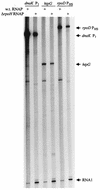Metabolic roles of a Rhodobacter sphaeroides member of the sigma32 family
- PMID: 9422586
- PMCID: PMC106842
- DOI: 10.1128/JB.180.1.10-19.1998
Metabolic roles of a Rhodobacter sphaeroides member of the sigma32 family
Abstract
We report the role of a gene (rpoH) from the facultative phototroph Rhodobacter sphaeroides that encodes a protein (sigma37) similar to Escherichia coli sigma32 and other members of the heat shock family of eubacterial sigma factors. R. sphaeroides sigma37 controls genes that function during environmental stress, since an R. sphaeroides deltaRpoH mutant is approximately 30-fold more sensitive to the toxic oxyanion tellurite than wild-type cells. However, the deltaRpoH mutant lacks several phenotypes characteristic of E. coli cells lacking sigma32. For example, an R. sphaeroides deltaRpoH mutant is not generally defective in phage morphogenesis, since it plates the lytic virus RS1, as well as its wild-type parent. In characterizing the response of R. sphaeroides to heat, we found that its growth temperature profile is different when cells generate energy by aerobic respiration, anaerobic respiration, or photosynthesis. However, growth of the deltaRpoH mutant is comparable to that of a wild-type strain under each of these conditions. The deltaRpoH mutant mounted a heat shock response when aerobically grown cells were shifted from 30 to 42 degrees C, but it exhibited altered induction kinetics of approximately 120-, 85-, 75-, and 65-kDa proteins. There was also reduced accumulation of several presumed heat shock transcripts (rpoD P(HS), groESL1, etc.) when aerobically grown deltaRpoH cells were placed at 42 degrees C. Under aerobic conditions, it appears that another sigma factor enables the deltaRpoH mutant to mount a heat shock response, since either RNA polymerase preparations from an deltaRpoH mutant, reconstituted Esigma37, or a holoenzyme containing a 38-kDa protein (sigma38) each transcribed E. coli Esigma32-dependent promoters. The lower growth temperature profile of photosynthetic cells is correlated with a difference in heat-inducible gene expression, since neither wild-type cells or the deltaRpoH mutant mount a typical heat shock response after such cultures were shifted from 30 to 37 degrees C.
Figures




 ) cells are shown.
) cells are shown.




Similar articles
-
Transcription of the Rhodobacter sphaeroides cycA P1 promoter by alternate RNA polymerase holoenzymes.J Bacteriol. 1998 Jan;180(1):1-9. doi: 10.1128/JB.180.1.1-9.1998. J Bacteriol. 1998. PMID: 9422585 Free PMC article.
-
Activity of Rhodobacter sphaeroides RpoHII, a second member of the heat shock sigma factor family.J Bacteriol. 2006 Aug;188(16):5712-21. doi: 10.1128/JB.00405-06. J Bacteriol. 2006. PMID: 16885439 Free PMC article.
-
Isolation, identification, and transcriptional specificity of the heat shock sigma factor sigma32 from Caulobacter crescentus.J Bacteriol. 1996 Apr;178(7):2094-101. doi: 10.1128/jb.178.7.2094-2101.1996. J Bacteriol. 1996. PMID: 8606189 Free PMC article.
-
Regulation and conservation of the heat-shock transcription factor sigma32.Genes Cells. 1996 Mar;1(3):277-84. doi: 10.1046/j.1365-2443.1996.28028.x. Genes Cells. 1996. PMID: 9133661 Review.
-
Singlet oxygen stress in microorganisms.Adv Microb Physiol. 2011;58:141-73. doi: 10.1016/B978-0-12-381043-4.00004-0. Adv Microb Physiol. 2011. PMID: 21722793 Review.
Cited by
-
CceR and AkgR regulate central carbon and energy metabolism in alphaproteobacteria.mBio. 2015 Feb 3;6(1):e02461-14. doi: 10.1128/mBio.02461-14. mBio. 2015. PMID: 25650399 Free PMC article.
-
Transcription of the Rhodobacter sphaeroides cycA P1 promoter by alternate RNA polymerase holoenzymes.J Bacteriol. 1998 Jan;180(1):1-9. doi: 10.1128/JB.180.1.1-9.1998. J Bacteriol. 1998. PMID: 9422585 Free PMC article.
-
The sRNA SorY confers resistance during photooxidative stress by affecting a metabolite transporter in Rhodobacter sphaeroides.RNA Biol. 2015;12(5):569-77. doi: 10.1080/15476286.2015.1031948. RNA Biol. 2015. PMID: 25833751 Free PMC article.
-
Conserved regulatory elements of the promoter sequence of the gene rpoH of enteric bacteria.Nucleic Acids Res. 2001 Jan 15;29(2):380-6. doi: 10.1093/nar/29.2.380. Nucleic Acids Res. 2001. PMID: 11139607 Free PMC article.
-
Shedding light on a Group IV (ECF11) alternative σ factor.Mol Microbiol. 2019 Aug;112(2):374-384. doi: 10.1111/mmi.14280. Epub 2019 May 31. Mol Microbiol. 2019. PMID: 31111523 Free PMC article. Review.
References
-
- Babst M, Hennecke H, Fischer H-M. Two different mechanisms are involved in the heat-shock regulation of chaperonin gene expression in Bradyrhizobium japonicum. Mol Microbiol. 1996;19:827–839. - PubMed
-
- Bethesda Research Laboratories. BRL pUC host: Escherichia coli DH5αTM competent cells. Bethesda Res Lab Focus. 1986;8:9–10.
-
- Bryant, D., and T. Gruber. Personal communication.
Publication types
MeSH terms
Substances
Associated data
- Actions
Grants and funding
LinkOut - more resources
Full Text Sources

